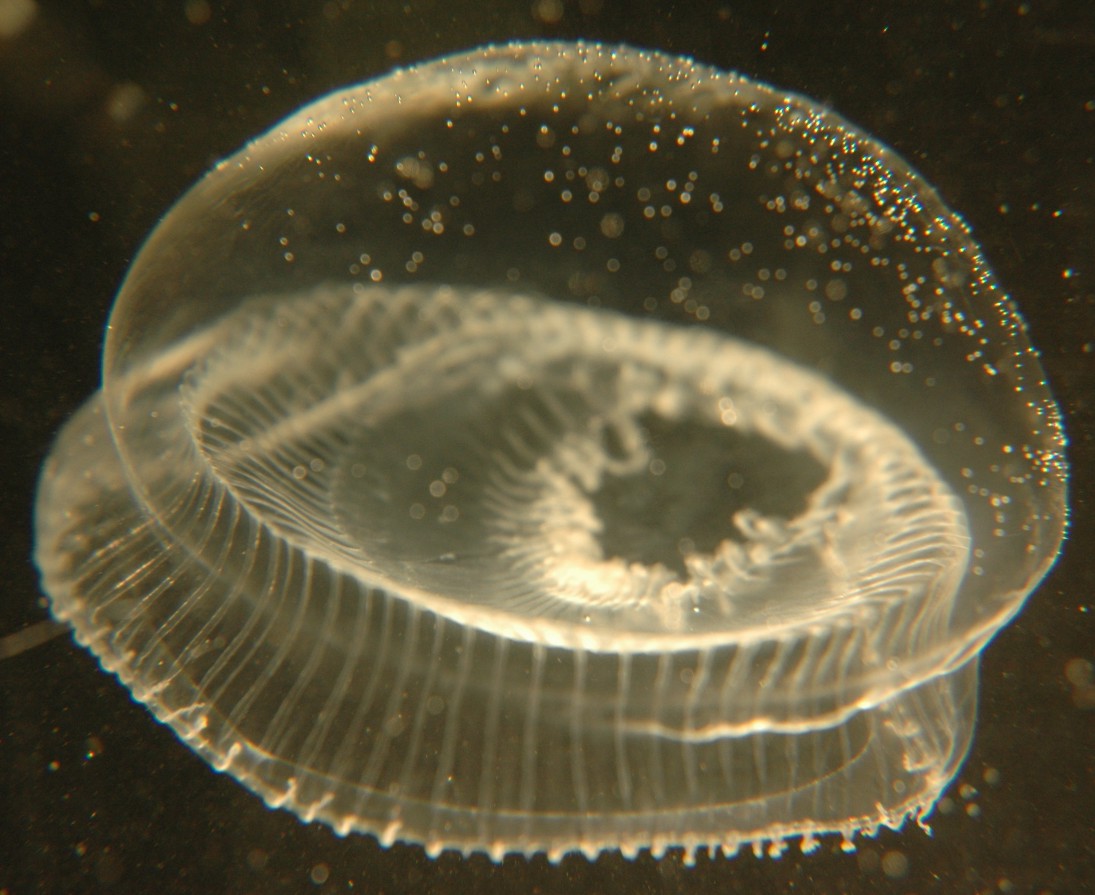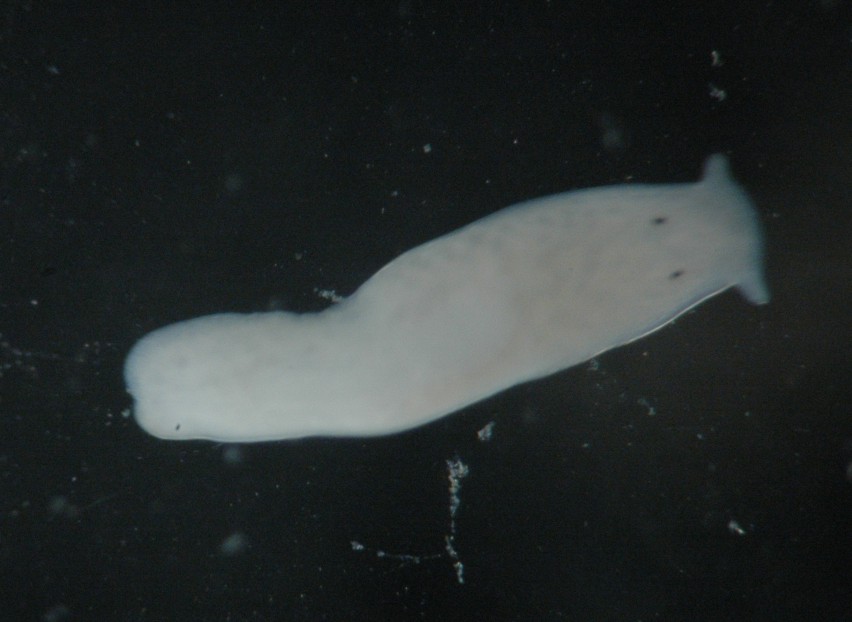Aequorea victoria (Murbach and Shearer, 1902)Common name(s): Many-ribbed hydromedusa, Water jellyfish |
|
| Synonyms:Aequorea aquorea, Aequorea flava, Aequorea forskalea |  |
|
Phylum Cnidaria
Order Leptomedusae
Family Aequoreidae
|
|
| Aequorea victoria, 4 cm diameter, captured in central Rosario Strait July 12, 2007. The broad, open manubrium with frilly lips can be seen through the bell. The tentacles are retracted. | |
| (Photo by: Dave Cowles, July 2007) | |
How to Distinguish from Similar Species: Aequorea spp range from Alaska to Baja California, and get much larger than this species (to 25 cm) off Alaska.
Geographical Range: British Columbia to central California. Closely related species can be found in other parts of the Pacific, on the U.S. Atlantic coast from Maine to Texas, and in the Mediterranean Sea.
Depth Range:
Habitat: Pelagic, often nearshore.
Biology/Natural History: This is the largest of our local Hydrozoan jellyfish, though the Scyphozoan jellyfish can grow much larger. Feeds mainly on gelatinous plankton such as Mitrocomella polydiademata and other hydromedusae, on ctenophores, on polychaetes, and on appendicularians. It may occasionally be cannibalistic. Also eat larval fish such as Pacific herring, Clupea pallasi. This species is bioluminescent and may flash brightly when disturbed. A related species off Baja California can divide by fission. The hydroid stage of this polyp is not often seen in the field. Some references suggest that the polyps may be what is now identified as Campanulina forskali.
Aequorea victoria is the source for "green
fluorescent protein",
which is a marker used in molecular biology.
| Return to: | |||
| Main Page | Alphabetic Index | Systematic Index | Glossary |
References:
Dichotomous Keys:Flora and Fairbanks, 1966
Kozloff 1987, 1996
Smith and Carlton, 1975 (as Aequoria sp)
General References:
Harbo,
1999
Kozloff,
1993
McConnaughey
and McConnaughey, 1985 (as Aequorea aequorea)
Niesen,
1994
Niesen,
1997
O'Clair
and O'Clair, 1998
Sept,
1999
Wrobel
and Mills, 1998
Scientific Articles:
Costello,
John H., Sean P. Colin, and John O. Dabiri, 2008.
Medusan morphospace:
phylogenetic constraints, biomechanical solutions, and ecological
consequences.
Invertebrate Biology 127(3): 265-290
Nancy E. Freitag,* and Kathleen E. Jacobs, 1999.
Examination of
Listeria monocytogenes Intracellular Gene Expression by Using the Green
Fluorescent Protein of Aequorea victoria. Infection and
Immunity
67:4 1844-1852
Mats Ormö, Andrew B.
Cubitt,
Karen Kallio, Larry A.
Gross, Roger
Y. Tsien, S. James Remington, 1996.
Crystal Structure
of the Aequorea victoria Green Fluorescent Protein. Science
273:
1392-1395
Douglas C. Prasher, Virginia K. Eckenrode, William W. Ward,
Frank G.
Prendergast and Milton J. Cormier, 1992. Primary structure of
the
Aequorea victoria green-fluorescent protein. Gene 111:
229-233
Purcell, JE; Siferd, TD; Marliave, JB,
1987. Vulnerability
of larval herring (Clupea harengus pallasi ) to capture by the
jellyfish
Aequorea victoria . Marine Biology 94:2 157-162
Reum, Jonathan P., Mary E. Hunsicker, and Caroline E. Paulsen,
2010.
Species composition and relative abundance of large medusae in Puget
Sound,
Washington. Northwest Science 84:1 pp. 131-140
Christoph
Reichel, Jaideep Mathur, Peter Eckesdagger , Kerstin Langenkemper,
Csaba
Koncz, Jeff Schell, Bernd Reiss, and Christoph MaasDagger, 1996.
Enhanced green fluorescence by the expression of an Aequorea victoria
green
fluorescent protein mutant in mono- and dicotyledonous plant
cells.
Proceedings of the National Academy of Sciences 93: 5888-5893
Vroemen S.F.; De Jonge H.; Van Marrewijk W.J.A.; Van der Horst
D.J.;
Cao C.; A. Ashton-Miller J.; Schultz A.B.; Alexander N.B.; Monger
B.C.1;
Chinniah-Chandy S.; Meir E.; Billings S.; Greene C.H.; Wiebe P.H.,
1998.
Sound scattering by the gelatinous zooplankters Aequorea victoria and
Pleurobrachia
bachei. Deep-Sea Research Pert II: Topical Studies in
Oceanography
45:7 1255-1271
Amsterdam A, Lin S, Hopkins N., 1995. The Aequorea victoria
green
fluorescent protein can be used as a reporter in live zebrafish
embryos.
Developmental Biology 171:1 123-129
Web sites:
General Notes and Observations: Locations, abundances, unusual behaviors:
This species is less common around Rosario in late spring and
early
summer but becomes quite common by the end of summer.

June 30, 2009: Many Aequorea
victoria are washing up on the beach at Rosario
Bay. Most
of them are moribund, and have this flatworm crawling over
them.
The flatworm is up to 5 mm long.
Authors and Editors of Page:
Dave Cowles (2006): Created original page
Jonathan Cowles (2007): Updated page with CSS